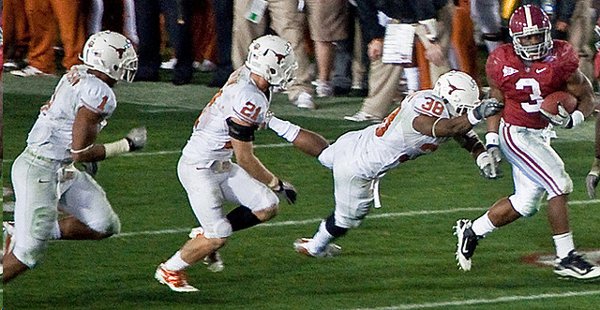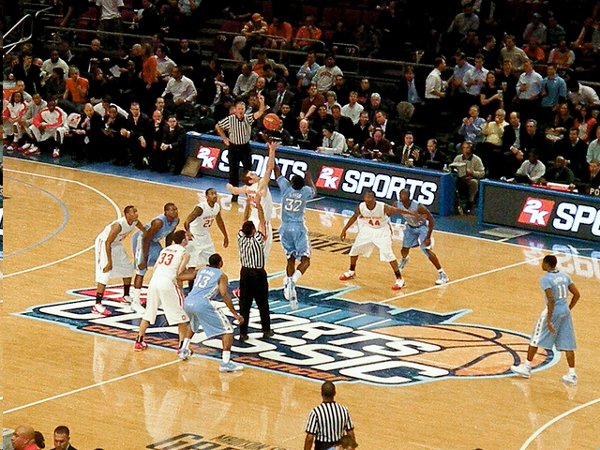Cashing in on College Athletics

From our content partner New America Media:
PASADENA, Calif. – The lucrative college football bowl season has just ended but the basketball tournament dubbed “March Madness” is near, guaranteeing that collegiate sports will generate big income from games early in 2014.
However, this year will also usher in another contest – and the outcome of this match could radically reshape a financial system that generates priceless promotions for corporations and billions of dollars for universities and television networks.
Consider the stakes in U.S. college football and basketball, the premier generators of amateur sports wealth in a world dominated by professional sports leagues. In accounting math, college football and basketball equal big broadcast contracts, tremendous revenue from ticket sales, massive merchandising and deals and the licensing of images of college athletes to video game manufacturers. Also, college football produces gushers of cash in corporate sponsorships for the big gridiron bowl games.
Green with Pride
Out-of-town visitors to the Rose Bowl and Tournament of Roses Parade generate $140 million in spending, according a recent report by Micronomics, a Los Angeles-based research and consulting company.
That’s a lot of green - and the same can be said about the number of green-clad alumni and fans who arrived in Southern California to show their support for the Michigan State University (MSU) Spartans in the 100th Rose Bowl game in Pasadena on Jan. 1.
Such fan support is one reason college football is so lucrative. Alumni fellowship is part of the appeal because college sports bring together people across lines of age, class and race, said Stephanie Harris-Byers, president of the Los Angeles chapter of the Michigan State University Black Alumni.
“It’s a beautiful thing,” said Harris-Byers.
Many MSU fans who wanted to attend the game faced a challenge when the university quickly sold their allotment of 24,000 tickets in December. Tickets broker agencies were selling individual tickets with a face value of $150 to $185 for a minimum of $400 and as high as $1,000 or more. Considering the high ticket prices, there was uncertainty about how many Spartan fans would attend.
An MSU pep rally in Los Angeles the day before the game was an indicator. MSU officials expected 10,000 at the rally but about 27,000 attended. Michigan residents Kristin Glovac, her mother and her grandmother - all MSU grads - were among those at the pep rally.
“Michigan State played in its last Rose Bowl in 1988,” said Kristin Glovac. “I was only six months old at that time. I’ve been waiting my whole life for this game.”
An estimated 60,000 green-attired MSU fans attended the Rose Bowl game, demonstrating the willingness of fans to spend heavily on college sports.

Litigation
But the very college athletes who are generating big profits for schools and businesses are barred – under the National Collegiate Athletic Association’s (NCAA) own rules – from receiving any compensation. In the last few years, a handful of former college athletes, including notable football and basketball stars, have come out to denounce the inequity, saying they should share in the wealth they are producing. Former UCLA standout Ed O’Bannon became the face for the movement when he filed an anti-trust lawsuit against the NCAA in 2009 for profits made from his image in advertisements and video games.
The college athletes who generate revenue in all sports will be compensated for the first time in the 107-year history of the NCAA if O’Bannon wins his lawsuit (O’Bannon vs. NCAA). The litigation is in the spotlight again, because the case is expected to go to court in June, and because more and more media commentators, scholars and law professors are siding with the athletes and calling for reforms.
“While the NCAA, its member conferences and schools, and its for-profit business partners reap millions of dollars from revenue streams ... former student athletes whose likenesses are utilized to generate those profit centers receive no compensation whatsoever," the suit says.
A court recently ruled that the case cannot proceed as a class-action suit and that athletes would have to sue individually. However, if the court rules in favor of O’Bannon, the judge is expected to establish a remedy that would affect all former and current athletes.
Regardless of the outcome, the lawsuit has prompted some action: EA Sports and Collegiate Licensing Company agreed in September to a $40 million settlement for using images of former athletes on their annual college football video game. EA also agreed to stop producing the game.
That development and other matters relating to the case have been closely covered by black-owned media partly because African-American athletes outnumber whites in Division I college football and basketball. Some of that coverage has framed the litigation as a civil rights issue. Some reports have cited the comments of civil rights scholar Taylor Branch, who has called NCAA sports a “plantation” system.

For example, the issue has been fodder for journalist Roland Martin, who has talked about the issue on his show on the black-owned TV One network. He made the following comment in his syndicated column.
“There is nothing more powerful than seeing athletes, not lawyers or journalists, standing up and singing that familiar civil rights anthem, ‘I woke up this morning with my mind stayed on freedom!’”
The mainstream media is also closely covering the case partly because more and more thought leaders on sports issues – ESPN’s Jay Billus and National Public Radio commentator Frank Deford among them – have said college athletes are employees and deserve to be paid.
More and more legal scholars are coming to the same conclusion. In a paper in the Washington Law Review, Robert and Amy McCormick, married Michigan State University law professors, referenced the National Labor Relations Act, which governs private-sector labor relations.
”In short,” the paper says, “the relationship between the university and the scholarship athlete is that of employer and employee. Employers pay their employees in exchange for services. Universities likewise award grants-in-aid to athletes in exchange for the athletes’ services in their sports.”
The NCAA, which had refused direct comment on the suit because of the ongoing litigation, issued a statement when it asked a court to dismiss the case.
"The NCAA's rules do not force athletes who wish to be professionals to enroll in school. Instead, the [O’Bannon suit seeks] to professionalize a few college athletes, which would lead to a reduction in athletic and educational opportunities for the vast majority of male and female student-athletes who pursue Division I, II and III athletics."
The dispute is also back in the news in the wake of the recent bowl season. The 35 bowl games staged last year generated $445.6 million. Of that total, the bowls distributed $300.8 million to the collegiate conferences. The financial haul from the most recent spate of bowl games is expected to exceed last year’s totals.
The biggest bowl money-makers are the five games sanctioned by the Bowl Champion Series (BCS), a system created in 1998 to select two teams to play in a championship game. The BCS games are played by the nation’s top-ranked teams and carry the names of their sponsors – the Tostitos Fiesta Bowl, the Allstate Sugar Bowl, the Discover Orange Bowl, the Rose Bowl presented by VISIO. The final game of the season has been the VISIO BCS National Championship, pitting the No. 1 and No. 2 ranked teams.
However, the BCS system will be replaced next year with a four-team playoff series. The playoffs, which will give more teams an opportunity to compete for the national championship, are designed to create more fan interest and even more revenue. However, if the O’Bannon suit is successful, the current college sports business model – like the BCS – will come to an end.






























































































































































































































































































































